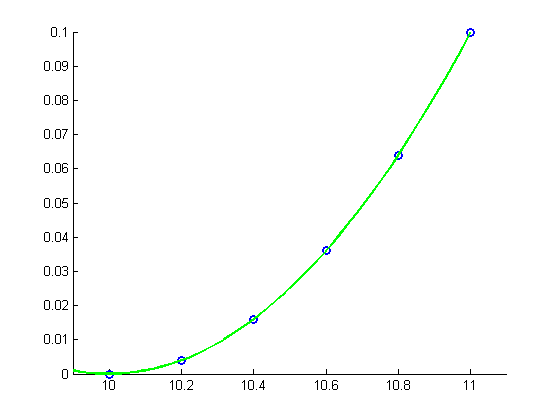LSQquadOrtho.m
Contents
Overview
Illustrates the use of an orthogonal basis for the computation of a polynomial least squares fit
Solving the normal equations in single precision using an orthogonal basis

clear all close all x = [10:0.2:11]'; y = [0:0.2:1]'.^2/10; m = length(x); hold on plot(x, y, 'bo', 'LineWidth',2) xlim([9.9 11.1]) ylim([0 0.1]) pause disp('Using single-precision with orthogonal basis') A = [single((x-21/2).^2-7/60) single(x-21/2) ones(m,1)] % Solve the normal equations c = single((A'*A))\single((A'*y)) xx = linspace(9.9,11.1,50); yy = c(1)*((xx-21/2).^2-7/60)+c(2)*(xx-21/2)+c(3); plot(xx, yy, 'g-', 'LineWidth', 2) hold off disp(sprintf('There no longer is a problem with the condition number of A^TA.')) disp(sprintf('cond(A^TA) = %e\n',cond(A'*A))) disp(sprintf('For comparison, cond(A) = %e\n',cond(A)))
Using single-precision with orthogonal basis
A =
0.1333 -0.5000 1.0000
-0.0267 -0.3000 1.0000
-0.1067 -0.1000 1.0000
-0.1067 0.1000 1.0000
-0.0267 0.3000 1.0000
0.1333 0.5000 1.0000
c =
0.1000
0.1000
0.0367
There no longer is a problem with the condition number of A^TA.
cond(A^TA) = 1.004464e+002
For comparison, cond(A) = 1.002230e+001

Compute the inner products of the columns of  with each other to verify that
with each other to verify that  is an orthogonal matrix.
is an orthogonal matrix.
pause disp('Notice that the columns of A are orthogonal to each other:') disp(sprintf('A(:,1)''*A(:,2) = % f',A(:,1)'*A(:,2))) disp(sprintf('A(:,1)''*A(:,3) = % f',A(:,1)'*A(:,3))) disp(sprintf('A(:,2)''*A(:,3) = % f',A(:,2)'*A(:,3)))
Notice that the columns of A are orthogonal to each other: A(:,1)'*A(:,2) = 0.000000 A(:,1)'*A(:,3) = 0.000000 A(:,2)'*A(:,3) = 0.000000